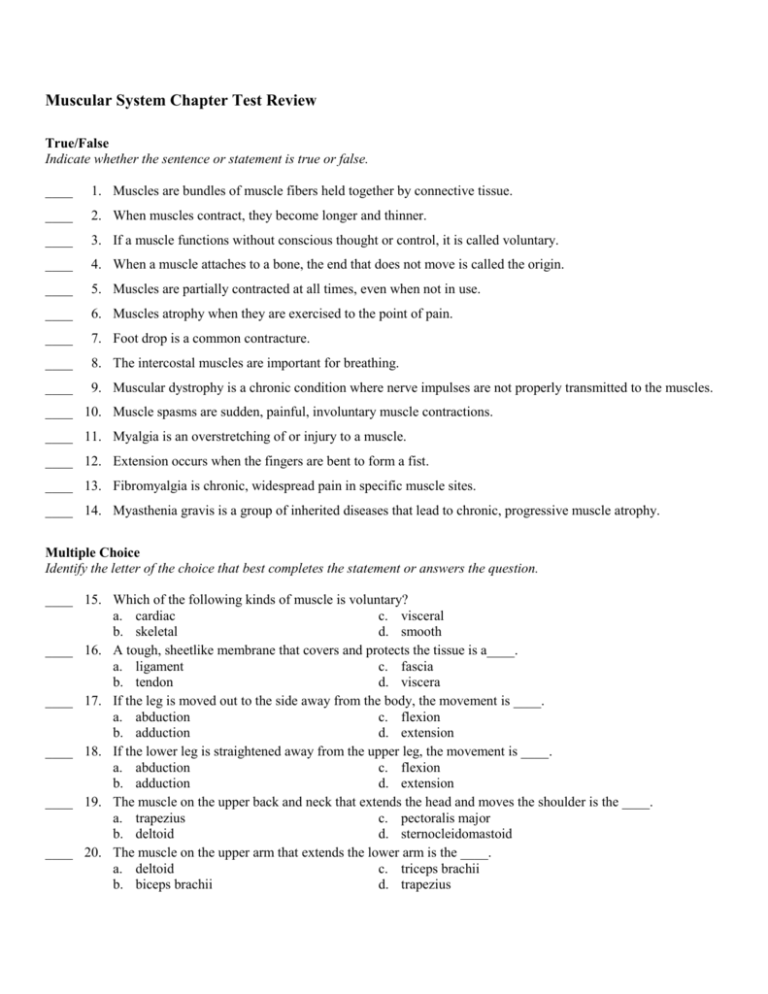Muscular System Chapter Test Review
advertisement

Muscular System Chapter Test Review True/False Indicate whether the sentence or statement is true or false. ____ 1. Muscles are bundles of muscle fibers held together by connective tissue. ____ 2. When muscles contract, they become longer and thinner. ____ 3. If a muscle functions without conscious thought or control, it is called voluntary. ____ 4. When a muscle attaches to a bone, the end that does not move is called the origin. ____ 5. Muscles are partially contracted at all times, even when not in use. ____ 6. Muscles atrophy when they are exercised to the point of pain. ____ 7. Foot drop is a common contracture. ____ 8. The intercostal muscles are important for breathing. ____ 9. Muscular dystrophy is a chronic condition where nerve impulses are not properly transmitted to the muscles. ____ 10. Muscle spasms are sudden, painful, involuntary muscle contractions. ____ 11. Myalgia is an overstretching of or injury to a muscle. ____ 12. Extension occurs when the fingers are bent to form a fist. ____ 13. Fibromyalgia is chronic, widespread pain in specific muscle sites. ____ 14. Myasthenia gravis is a group of inherited diseases that lead to chronic, progressive muscle atrophy. Multiple Choice Identify the letter of the choice that best completes the statement or answers the question. ____ 15. Which of the following kinds of muscle is voluntary? a. cardiac c. visceral b. skeletal d. smooth ____ 16. A tough, sheetlike membrane that covers and protects the tissue is a____. a. ligament c. fascia b. tendon d. viscera ____ 17. If the leg is moved out to the side away from the body, the movement is ____. a. abduction c. flexion b. adduction d. extension ____ 18. If the lower leg is straightened away from the upper leg, the movement is ____. a. abduction c. flexion b. adduction d. extension ____ 19. The muscle on the upper back and neck that extends the head and moves the shoulder is the ____. a. trapezius c. pectoralis major b. deltoid d. sternocleidomastoid ____ 20. The muscle on the upper arm that extends the lower arm is the ____. a. deltoid c. triceps brachii b. biceps brachii d. trapezius ____ 21. The muscle on the upper chest that adducts and flexes the upper arm is the ____. a. deltoid c. rectus abdominus b. pectoralis major d. latissimus dorsi ____ 22. The muscle on the front of the thigh that extends the leg is the ____. a. sartorius c. gastrocnemius b. quadriceps femoris d. tibialis anterior ____ 23. The muscle that extends from the ribs to the pubis and compresses the abdomen is the ____. a. rectus abdominus c. pectoralis major b. latissimus dorsi d. gluteus maximus ____ 24. The muscle on the front of the lower leg that flexes and inverts the foot is the ____. a. sartorius c. quadriceps femoris b. gastrocnemius d. tibialis anterior ____ 25. The muscle on the buttocks that extends the thigh is the ____. a. sartorius c. latissimus dorsi b. rectus abdominus d. gluteus maximus ____ 26. A group of inherited diseases that lead to chronic, progressive muscle atrophy is ____. a. myasthenia gravis c. muscular dystrophy b. paralysis d. cerebral palsy Matching Match each item with the correct statement below. a. Abduction k. b. Adduction l. c. Circumduction m. d. Contractility n. e. Contracture o. f. Elasticity p. g. Excitability q. h. Extensibility r. i. Extension s. j. Fascia ____ ____ ____ ____ ____ ____ ____ ____ ____ ____ ____ ____ ____ ____ 27. 28. 29. 30. 31. 32. 33. 34. 35. 36. 37. 38. 39. 40. Flexion Insertion Involuntary Ligament Muscle tone Origin Rotation Tendon Voluntary State of partial contraction The end of a muscle that moves when the muscle contracts Severe tightening of a flexor muscle Control over the action of a muscle Ability of a muscle to be stretched Ability of a muscle to respond to a stimulus Ability of a muscle to return to its original shape Strong, tough, connective-tissue cord that attaches muscles to bones Moving a body part toward the midline Bending the lower arm up toward the upper arm Moving in a circle at a joint Increasing the angle between two bones Turning the head from side to side Moving the arm out to the side Identify the major superficial muscles of the anterior body. Identify the major superficial muscles of the posterior body. Muscular System Chapter Test Answer Section TRUE/FALSE 1. 2. 3. 4. 5. 6. 7. 8. 9. 10. 11. 12. 13. 14. ANS: ANS: ANS: ANS: ANS: ANS: ANS: ANS: ANS: ANS: ANS: ANS: ANS: ANS: T F F T T F T T F T F F T F MULTIPLE CHOICE 15. 16. 17. 18. 19. 20. 21. 22. 23. 24. 25. 26. ANS: ANS: ANS: ANS: ANS: ANS: ANS: ANS: ANS: ANS: ANS: ANS: B C A D A C B B A D D C MATCHING 27. 28. 29. 30. 31. 32. 33. 34. ANS: ANS: ANS: ANS: ANS: ANS: ANS: ANS: O L E S H G F R 35. 36. 37. 38. 39. 40. ANS: ANS: ANS: ANS: ANS: ANS: B K C I Q A







